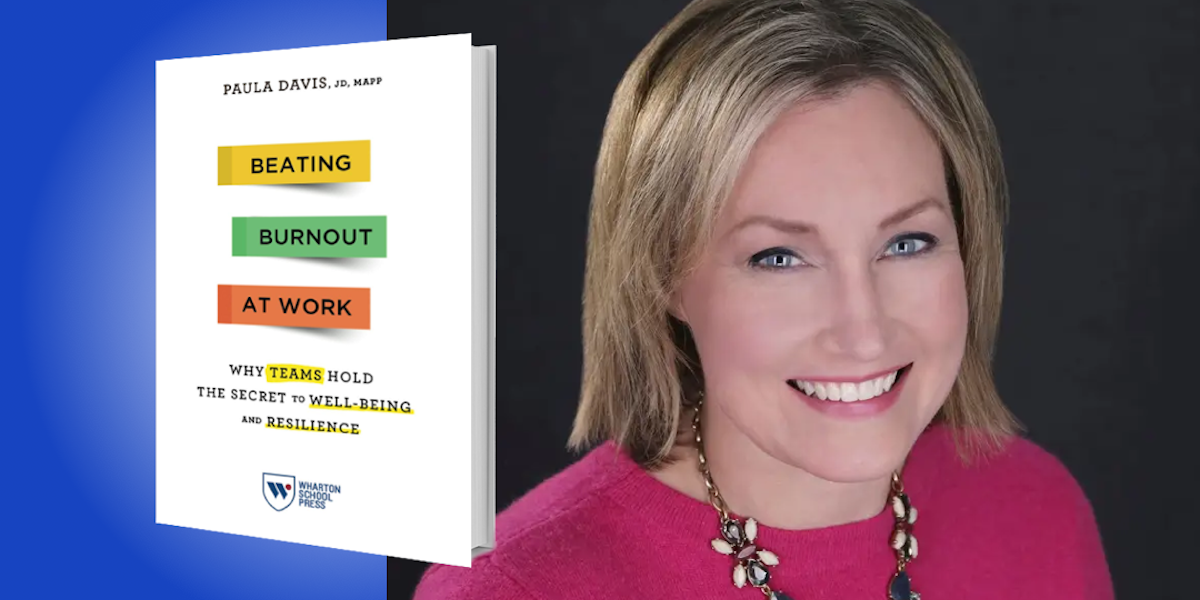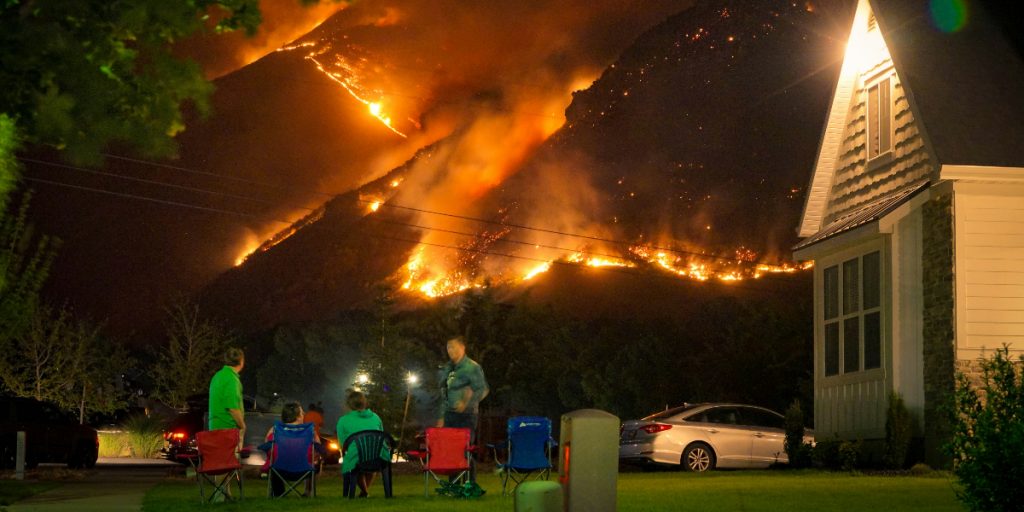Paula Davis is a former practicing lawyer turned stress and resilience expert. Her expertise has been featured in the New York Times, O, The Oprah Magazine, the Washington Post, and many other publications. She is also a contributor to Forbes, Fast Company, and Psychology Today.
Below, Paula shares 5 key insights from her new book, Beating Burnout at Work: Why Teams Hold the Secret to Wellbeing and Resilience (available now from Amazon). Download the Next Big Idea App to listen to the audio version—read by Paula herself—and enjoy Ideas of the Day, ad-free podcast episodes, and more.
1. When it comes to preventing burnout, we need to shift from individual-only strategies to also include systems-based frameworks.
I burned out during what became the last year of my law practice. That’s the thing that sent me into phase two of my career, which I’ve been pursuing now for more than 10 years. I burned out because I missed a whole host of warning signs.
I missed that I was chronically physically and emotionally exhausted. I missed that I was chronically cynical—people were really annoying me and bugging me. I was starting to sense a loss of confidence, not in my ability to be a good lawyer, but in my ability to see a meaningful path within the legal profession, and that resulted in a sense of lost impact. I walked into work thinking “why bother, who cares.” When I finally realized that I was burning out, I started to study what really leads to burnout.
I had spent a long time thinking that this was somehow my fault, that this was a flaw in my personality. But it was actually me not having good stress-management techniques and tools. There is an individual component to burnout, but the bigger driver of why people are burning out is because of the system.
It’s because of how your leader leads, how your team is oriented, organizational practices and policies, and culture and environment. Those things together tend to drive whether or not people burn out at work. It’s not just individual strategies that are going to help. We have to draw in the rest of the organization to meaningfully address this issue.
2. Burnout is complex.
One of the problems with burnout is that it tends to be oversimplified as a process, often considered just a syndrome of exhaustion. There are three big dimensions of burnout that we need to pay attention to.
“On Sunday night I would stare at the clock on the wall, hoping that I could freeze time.”
The first one is chronic physical and emotional exhaustion. When I was going through the process of burning out, nothing seemed to refuel my tank. I used to be really energized—jumping out of bed, ready to tackle my client’s legal challenges on Monday mornings. That turned into a really slow, dropping thud on Monday mornings, where on Sunday night I would stare at the clock on the wall, hoping that I could freeze time. No matter what I did, the weekend just didn’t seem to be enough in terms of reenergizing myself. It got to the point where I just wanted the couch and some bad reality television because I wasn’t able to handle even a low-effort activity.
Oftentimes we see burnout as this thing that produces a lot of physical and emotional exhaustion, and so we try to apply self-care or self-help remedies to help people deal with the exhaustion. While that’s not a bad thing, it tends to miss the mark because burnout is also about being chronically cynical. That is, people generally annoy and bug you, and that includes your clients, your colleagues, or even your own family.
I remember a lot of internal eye-rolling when my clients would call me. Outwardly, I was always very professional, but inwardly, I would think to myself, “Do you really need my help with this? You’re not going to listen to my advice anyway.” I had always been somebody who wanted to stand side-by-side with my clients, trying to help them deal with the issues they faced, but I really started to detach from that willingness to be part of their team.
Burnout is also about having a sense of lost impact. The research calls it inefficacy—the “why bother, who cares” mentality.
It’s this trio of things that we have to pay attention to; it’s not so simple as telling somebody to take a Friday off or go on vacation and get more sleep. When you’re truly experiencing burnout, hearing those types of sentiments can feel disingenuous.
We have to really start looking at what causes burnout. The research gives us some great direction about job demands that can set people up for a greater likelihood of burning out, things like lack of autonomy, being overextended, feeling alone, unfair work environment, lack of transparency, arbitrary decision-making, favoritism, value disconnect, and lack of recognition.
“If we can give teams these tools, then they can get their systems and their cultures going in the right direction to slow burnout.”
We have to deepen our conversation about burnout, drilling down into what’s really causing it. Those conversations need to be had with teams and leaders in order to deal with those job demands that might be causing it.
3. Engagement and burnout can travel together.
A lot of research positions engagement as the opposite of burnout, but from my own experience, it didn’t seem to match. They can go together.
In one example, about 20% of folks in a study were classified as both highly engaged and highly burnt out. They still felt like they wanted to do good work and were doing good work, but they were also really frustrated and stressed. This highly engaged, yet highly burnt out group had a higher level of turnover than the group that was actually the most burnt out. One team in particular from the study had about 28% to 44% rate of burnout, but they were in the top tier for engagement scores within the organization. Recently, there was some work done looking at burnout rates and satisfaction rates broadly within a group of lawyers and it saw the same thing: about 29% of the lawyers who were burnt out also reported a satisfaction score of their work at seven or higher on a scale of 10. So, people are saying “I’m really satisfied, but I’m also really stressed and burnt 0ut.”
We need to make sure that people have enough resources because a lot of the people in this highly engaged, highly burnt out group felt like they weren’t necessarily getting enough feedback, autonomy, recognition, leader support, transparency, role clarity, or clear decision-making. Prioritizing those important job resources can help mitigate driving factors of burnout.
4. Teams are important in preventing burnout.
When I was digging into the research on burnout, it became clear that we have to look beyond individual strategies. Organizational strategies tend to be the most effective at preventing burnout, but it would be too difficult to walk into an organization and say, “Hey guys, you just have to change your culture.” That was not going to get leader buy-in. However, the individual conversation is an easy sell for organizations to start tackling the underlying root causes or burnout.
“Be a little bit more intentional about orienting your day around an aspect of your work that gives you meaning.”
So, what’s ultimately going to move the needle? Where is the spot where I can start to effect some change and reach other places within the system? The answer is teams. If we can give teams these tools, then they can get their systems and their cultures going in the right direction to slow burnout, and hopefully that can have ripple effects within the organization. With a team approach, I can talk about strategies that can build resilience at the team level, while still talking about the individual strategies that slow burnout.
To take it a step further, I created a model that looked at what creates high-performing, resilient, thriving teams. A number of different traits bubbled up to the top, with psychological safety and psychological needs as the foundation: relationships, impact, and meaning. The mental strength of how we all think under stress and pressure influences our teams, and how our teams collectively think under stress and pressure is important energy.
If we realize tweaks need to be made within our team system, our little mini-culture, we can do that much more easily than a giant systemic overhaul.
5. The importance of tiny, noticeable things.
Small interactions add up—for example, asking one simple question or keeping track of a small success and sharing that with your team. Be a little bit more intentional about orienting your day around an aspect of your work that gives you meaning, then combine that with a five-minute interaction with a colleague, or even just a smile or eye contact. Be supportive when somebody shares good news, or give a colleague encouragement.
All of these little things add up over time to something really big and powerful. It’s important for people to know that you don’t have to wildly shift or change your culture and behaviors. It’s sometimes enough to just be more conscious of these tiny, noticeable things and be more intentional about adding them into your day, building them into your leadership repertoire, and discussing them with your teams. Tiny, noticeable things can really influence whether burnout is more or less likely to happen in your environment.
To listen to the audio version read by Paula Davis, and browse through hundreds of other Book Bites from leading writers and thinkers, download the Next Big Idea App today:
































